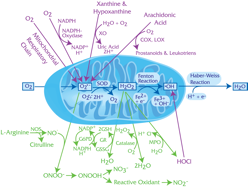Oxidative Stress: Research Products & Assay Kits
Oxidative stress results from an imbalance between an organism's multiple antioxidant defense mechanisms (including antioxidant enzymes and small molecule oxidant scavengers) and reactive oxygen species (ROS), which can irreversibly modify cellular components.
It is now well recognized that oxidative stress is a critical underlying condition that plays a major role in the pathogenesis of many human diseases. ROS react with a wide range of biomolecules, including lipids, proteins and nucleic acids, and many of the byproducts thus formed have been extensively characterized.
Oxidative Stress Biomarker Products:
Additional Information:
White Papers:
- The Isoprostanes: Unique Bioactive Products of Lipid Peroxidation.
- Impact of Isoprostane Metabolism on the Assessment of Oxidative Stress.
- Isoprostanes: Biomarkers for Oxidative Stress.
Posters:
- Isoprostane ELISA vs. GC/MS
- Isoprostane Glucuronides
Biomarkers and the Assessment of Oxidative Stress
The efforts of many investigators have led to the identification of hundreds of biomolecules that are derived from the interaction of free radicals with biomolecules. Assays for some of these oxidative stress biomarkers (e.g. Isoprostanes, MDA, 4-HNE and 8-HO-dG) have been widely used.
However, many traditional assays are cumbersome and/or unreliable so that wide variations in results have been reported by different laboratories. Therefore, the development of reliable assays to monitor oxidant stress is a major research focus at Oxford Biomedical Research, Inc.
Lipid peroxidation byproducts: The oxidation of unsaturated fatty acids is a well-established mechanism of cellular injury, and the byproducts of these reactions are established OS biomarkers.
-
Isoprostanes: are prostaglandin-like compounds that are produced upon peroxidation of arachidonic acid. Measurement of isoprostane concentrations is often called the “gold standard” for assessment of oxidative stress. Oxford Biomedical pioneered the development and validation of immunoassays for the quantification of isoprostanes. See Isoprostanes
-
TBARS: The TBARS (ThioBarbituric Acid Reactive Substances) is a well-established and widely used method for assessment of oxidative damage. However, as typically performed, TBARS analysis requires boiling with strong acids and is criticized for lack of specificity and sensitivity.We recently developed a room temperature TBARS method that • eliminates the requirement for high concentrations of strong acids, • increases sensitivity, • reduces interfering substances, and • cuts reaction time in half. This results in more accurate, precise and reliable TBARS measurements. See Accurate TBARS Assays
-
Malonaldehyde (MDA) and 4-hydroxy-2(E)-nonenal (4-HNE): These end products derived from the breakdown of polyunsaturated fatty acids and related esters provide a convenient index of lipid peroxidation. Our simple and reliable colorimetric method for the quantification of MDA and 4-HNE, uses the reaction of a chromogenic reagent with MDA and 4-HNE (or MDA alone without interference with 4-hydroxyalkenals) in aqueous samples. See Lipid Peroxidation Assays
-
HODEs: Linoleic acid is the predominant polyunsaturated fatty acid (PUFA) in the human diet. The peroxidation of linoleic acid gives rise to hyproperoxyoctadecadienoic acids (HPODEs), which are rapidly reduced to the corresponding hydroxy compounds. 9-HODE and 13(S)-HODE, are the most widely distributed of the known linoleic acid metabolites. See HODE Assays
DNA damage byproducts: Oxidatively damaged DNA is a major contributor to diseases. Hence, multiple repair mechanisms exist, and the byproducts of repair can be monitored in biofluids.
-
8-Hydroxy-2’-Deoxyguanosine: 8-OHdG is excised during the repair of oxidative damage to dG sites in DNA and has been widely used as a biomarker for oxidative damage. Our competitive ELISA kits employ a monoclonal antibody specific for 8-OHdG quantification in tissue, serum, plasma or urine samples. See 8-OG-dG Assay
-
AP sites: Apurinic/apyrimidinic (AP) sites are one of the major DNA lesions that occur during base excision and repair of oxidized, deaminated or alkylated bases. It has been estimated that ~2 x105 base lesions are generated per cell per day. The level of AP sites in cells can be a good indicator of DNA lesion and repair against chemical damage and cell aging. This kit utilizes an Aldehyde Reactive Probe (ARP) that reacts specifically with an aldehyde group exposed in AP sites of purified DNA samples. See AP site Assay
-
Anti-M1dG Adduct: This monoclonal antibody has been extensively characterized and is highly specific for M1G-dR. It has been used for immunoaffinity isolation of M1G-dR prior to GC/mass spectrometry. See Anti-M1-dG
Protein damage byproducts: Multiple amino acid residues react with ROS. Some of the byproducts result in irreversible inactivation of proteins. Others are now known to be involved in ROS-mediated signaling reactions.
-
Anti-Nitrotyrosine: 2-Nitrotyrosine is a major, irreversible byproduct of protein oxidation that has been shown to be involved in the inactivation of multiple proteins. It is an excellent biomarker for protein oxidation, and this specific antibody can be used for Western blotting, IHC or ELISA. See Anti-NT
-
Protein Carbonyl ELISA: Protein carbonyls are generated by multiple oxidative mechanisms. Quantification of protein carbonyls is now recognized to be an excellent measure of the overall protein oxidation in biological samples. Our new protein carbonyl ELISA kit is sensitive, reliable, includes control proteins, and is easy to use. See PC Assay
-
Immuno-spin trapping of protein radicals using DMPO: DMPO [5,5-dimethyl-1-pyrroline-N-oxide] has been widely employed for spin trapping in conjunction with ESR. In conjunction with rabbit anti-DMPO, (also available from Oxford Biomedical) is employed for the immunochemical identification and characterization of nitrone adducts that result from the reaction of protein radicals with DMPO.
